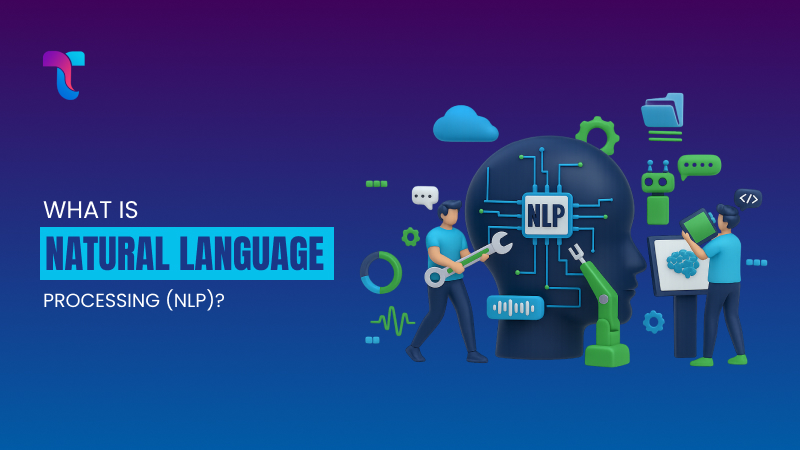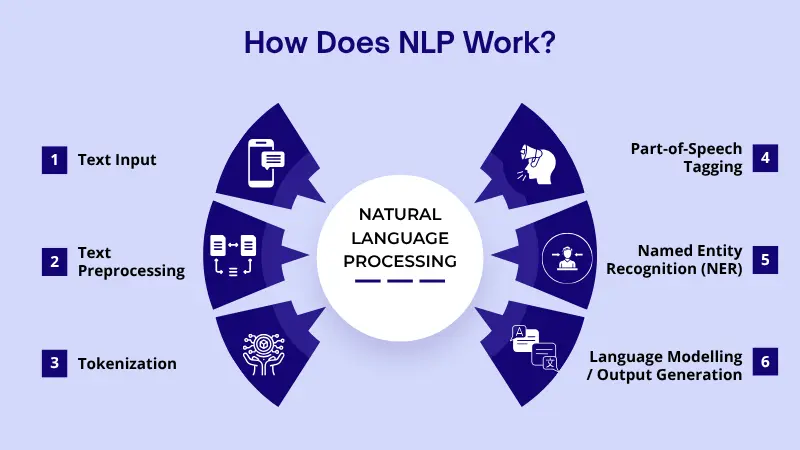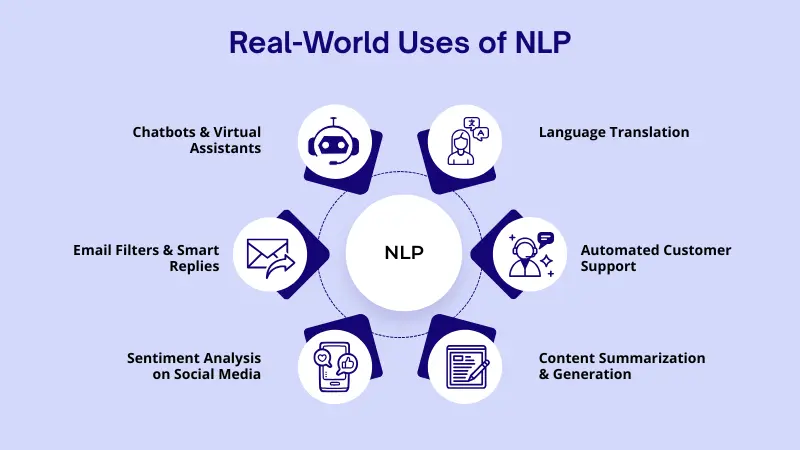Ever wondered how Alexa understands you or how chatbots reply instantly, almost like real humans? Well, it’s Natural Language Processing, or NLP!
It is the tech that lets machines understand, interpret, and respond to human language.
According to the latest study by Grand View Research, the global NLP market is estimated at USD 59.7 billion in 2024 and is projected to grow to around USD 439.85 billion by 2030. That massive growth shows how fast NLP is becoming central to AI applications in business, healthcare, customer service, and more.
As a branch of Artificial Intelligence (AI), NLP is one of the most exciting frontiers today. That’s because it bridges the gap between human communication and machine “thinking”. NLP in artificial intelligence helps computers to not just compute but talk.
Here’s a simple natural language processing guide for beginners where you’ll learn what NLP is and how it works, and more.
Without further delay, let’s begin the blog!
What Is Natural Language Processing (NLP)?
Let’s get a simple introduction to NLP!
Basically, natural language processing is a subfield of computer science and artificial intelligence (AI) that uses learning to enable computer systems to easily understand and communicate with human language.
NLP enables computers and digital devices to identify, understand, and generate text classification. It combines computational linguistics and models of human language with statistical modelling, machine learning, and deep learning for NLP.
Some of the best examples of NLP in daily life include texting chatbots for instant customer support, using voice-operated GPS systems, and questioning smartphones’ voice assistants like Siri or Gemini.
Well, it is the simple explanation of natural language processing!
Why Is NLP Important?
The importance of natural language processing is non-ignorable. It enables machines to understand and interact with human language. But why does that matter so much?
Here are a few key reasons:
It Helps Humans & Machines Communicate
NLP allows people to communicate with machines in a natural and human way, either through spoken or written language. Instead of learning how to “talk” like a computer, users can interact using everyday language.
It Powers the Tools We Use Every Day
Many tools we rely on daily are built on NLP. From voice assistants like Siri and Alexa to predictive text, chatbots, and translation apps, NLP is what enables these tools to understand and respond to us accurately.
It is Transforming Industries
In fields like customer service, healthcare, finance, and education, NLP helps by taking care of those boring, repetitive language tasks. It can analyze large volumes of text, extract key insights, and even generate reports. This saves time and improves productivity.
It Makes AI Smarter
NLP adds depth to AI systems by helping them grasp context, tone, sentiment, and intent, and not just keywords. This results in more impactful interactions and enhances decision-making in AI-driven applications.
It Breaks Language Barriers
Language translation with NLP helps us chat and connect with people from different countries and cultures. NLP is further enhancing the overall global connectivity through real-time translation and multilingual chatbots.
How Does NLP Work?
NLP is about teaching machines to make sense of human language. It is the way we speak, write, and even express emotions. Let’s understand NLP by using a simple example:
You type: “Book me a flight tomorrow.”
How does the system understand what you mean and take action? Here’s what happens behind the scenes:
Text Input
This is the starting point. The system first receives your message. In our example, the input is “Book me a flight tomorrow.”
Text Preprocessing
Before the system can understand the message, it needs to clean and prepare the text. This includes:
- Removing unnecessary punctuation
- Converting all text to lowercase
- Eliminating common “filler” words like a, the, or
After preprocessing, the input becomes something like: “book flight tomorrow”
Tokenization
The sentence is then broken down into individual words or phrases, called tokens. This helps the system analyze each part of the message.
Tokens: [“book”, “flight”, “tomorrow”]
Part-of-Speech Tagging
Next, the system identifies the role of each word in the sentence. This step helps the system understand structure and grammar.
For example:
- “book” = verb (action)
- “flight” = noun (object)
- “tomorrow” = adverb/time
Named Entity Recognition (NER)
Here, the system looks for specific real-world references, such as dates, places, or names. In this case, it recognizes “tomorrow” = date/time
Language Modelling / Output Generation
The system now understands that you want to book a flight for tomorrow and can provide a relevant response or take action.
For example, it might:
- Show available flights
- Ask for a destination
- Proceed with booking
Final Result:
The system replies with something like: “Sure, where would you like to fly tomorrow?”
Real-World Uses of NLP
Now, let’s discuss some common real-life applications of NLP!
Chatbots & Virtual Assistants
NLP powers smart assistants like Siri, Alexa, and Google Assistant and helps them understand your voice commands and respond accurately. No matter whether you are just setting a reminder or asking for weather updates, NLP interprets natural speech and converts it into actions.
Email Filters & Smart Replies
Your email service uses NLP to detect spam, categorize emails, and suggest quick responses. For example, Gmail automatically filters junk mail and offers smart replies like “Thank you” or “Let’s do it.” NLP helps sort out your inbox by figuring out what your messages are talking about, what they really mean, and how they make you feel.
Sentiment Analysis on Social Media
Brands are using NLP these days to keep an eye on how people are really feeling about their products on the internet. By scanning tweets, comments, and reviews, NLP can determine if the sentiment is positive, negative, or neutral. This helps businesses figure out what their customers are thinking, so they can reply fast to feedback and make smarter marketing choices.
Language Translation
NLP technology enables tools like Google Translate and DeepL to function effectively by understanding grammar, context, and meaning, rather than just translating words. It helps keep the message clear and easy to understand. It helps people overcome language barriers, which makes global communication easier.
Automated Customer Support
A lot of businesses are using chatbots powered by AI to respond to customer questions 24/7. With NLP, these bots can understand customer questions, provide relevant answers, and even escalate complex issues. This really helps customers out and also shortens wait times while saving on support costs.
Content Summarization & Generation
NLP can help summarize long texts, which makes it perfect for news articles, research papers, and reports. It also powers tools for creating blog posts, emails, and product descriptions. So, basically, NLP helps us create content faster, makes it easier to come up with ideas, and opens it up for more people.
The Future of NLP
Well, its future is incredibly promising and we are just getting started. As AI continues to evolve, NLP is becoming even more advanced and is allowing machines to understand language contextually, emotionally, and even culturally.
We are quickly stepping into a world where AI can hold truly natural conversations and understand multiple languages seamlessly. This will reshape everything from customer service and content creation to legal analysis, healthcare, and more.
In fact, NLP is already considered one of the top emerging AI technologies transforming businesses in 2025. Businesses are using it to improve automation, personalize user experiences, and gain deeper insights from unstructured data like emails, reviews, and support tickets.
As NLP tools become more accurate, multilingual, and accessible, they will help businesses work smarter and not harder.
Wrapping Up
That’s a wrap for this blog!
NLP might sound like something straight out of a science fiction movie. As you can see, it’s a part of our daily lives.
And, as AI continues to grow, NLP will help businesses communicate better, automate faster, and understand their customers more deeply.
So, if you are just exploring NLP or thinking about using it in your business, one thing is for sure: the future of tech really understands you.
Are you now looking to integrate NLP into your digital solutions? Technoloader can help you turn top-notch ideas into real-world applications. Reach out to us and let’s together bring your vision to life!
FAQs
How does NLP work in simple terms?
NLP works by breaking language into smaller parts, such as words, phrases, and grammar. It then analyzes them using algorithms and machine learning to understand meaning, emotion, and intent.
Is NLP part of Artificial Intelligence?
Yes! NLP is a subfield of Artificial Intelligence (AI) that focuses on enabling computers to understand and generate human language naturally.
What are some common NLP applications?
Some of the most popular NLP applications include sentiment analysis, language translation, text summarization, speech recognition, and customer support chatbots.
How does NLP differ from Machine Learning?
Machine Learning is the broader concept of teaching computers to learn from data. NLP uses machine learning techniques to process and understand human language data specifically.
Can NLP understand emotions?
Yes, through sentiment analysis! NLP can detect whether a message or review is positive, negative, or neutral and helps businesses understand customer opinions.


